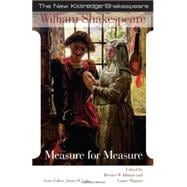
Note: Supplemental materials are not guaranteed with Rental or Used book purchases.
Purchase Benefits
Looking to rent a book? Rent Measure for Measure [ISBN: 9781585103478] for the semester, quarter, and short term or search our site for other textbooks by Shakespeare, William; Kliman, Bernice W.; Magnus, Laury; Lake, James H.. Renting a textbook can save you up to 90% from the cost of buying.
The New copy of this book will include any supplemental materials advertised. Please check the title of the book to determine if it should include any access cards, study guides, lab manuals, CDs, etc.
The Used, Rental and eBook copies of this book are not guaranteed to include any supplemental materials. Typically, only the book itself is included. This is true even if the title states it includes any access cards, study guides, lab manuals, CDs, etc.
Dating the Play
Measure for Measure appears to have been presented at court by Shakespeare’s company on St. Stephen’s night (December 26), 1604. Probably it was a new play, for it accords in style and temper with Shakespeare’s other work at about this time. At all events, 1604 is a reasonable date for its composition. Our only authority for the text is the First Folio, which must have been set up2 from a rather confused copy, certainly not from an autograph manuscript.
Possible Changes in the Play as Shakespeare Wrote It
Here and there one may detect possible cuts in the Folio text, but there is no good reason for ascribing any part of the play to another hand than Shakespeare’s, except, perhaps, the Duke’s rhyming speech at the end of Act 3, and this hardly deserves the harsh language which some critics have bestowed upon it. As marking the interval between two strongly contrasted scenes and introducing, prologue-like, the Mariana subplot, this moralizing chorus is neither out of place nor structurally inappropriate.It emphasizes the principle of “measure for measure” and at the end, justifies (to the audience) the Duke’s use of “craft against vice”; it also sums up his plan.
Sources and Analogues
The plot of Measure for Measure is mainly derived from George Whetstone’s two-part English play Promos and Cassandra, published in 1578, which, in turn, is founded on the fifth novel in the eighth decade of the Hecatommithi by the Italian author Giovanni Battista Giraldi (surnamed Cinthio or Cintio), first printed in 1565. Whetstone cannot have known Cinthio’s Epitia, a tragicomedy on the same theme as the novel. He remarks that he “divided the whole history into two Comedies because, it could not be conveyed in one.” He repeated his plot, as a narrative, in a storybook entitled An Heptameron of Civill Discourses (1582), noting incidentally that his play had never been acted. The substance of the tale existed in several variants before Cinthio wrote and was reported in 1547 as a recent actual current event.
But Shakespeare changed the story significantly. In Cinthio’s novel, Juriste the Governor (Shakespeare’s Angelo) promises Epitia (Shakespeare’s Isabella) to release her brother, who is under sentence of death, and assures her of his own hand in marriage, though without a definite promise. On these terms she yields. Juriste has the brother beheaded and sends the body to her, with the head at its feet. In Cinthio’s drama, however, as in Shakespeare’s plot, the keeper of the prison, without the Governor’s knowledge, substitutes a condemned criminal for the brother; and this important modification of the plot is also made by Whetstone. In both Cinthio and Whetstone the Sovereign decrees that the Governor shall marry the heroine and then shall be executed, but after the marriage, he spares the deputy’s life at Epitia’s entreaty. Neither Cinthio nor Whetstone has any character that corresponds to Mariana. By bringing her into the story, Shakespeare has transformed the plot and rescued Isabella from a really intolerable situation. She does not yield to Angelo, and it is the new character, Mariana, whom he must marry. Thus Isabella’s honor is preserved, and she is relieved of the necessity of marrying her worst enemy. The concluding speech shows that the Duke means to reward her with his own hand, if she is willing. This arrangement, which comes as something of a shock to modern readers, was doubtless quite acceptable to the Elizabethans, always eager for Jack to have his Jill. We may infer that Isabella gives up her purpose of becoming a votaress of Saint Clare (as seen in 1.4), but this is not stated, and the conclusion of the play leaves the audience guessing— as was doubtless Shakespeare’s intent.
In Promos and Cassandra Whetstone has sought to enliven the scene and make a strange plot more real by bringing in several low comedy subplots that illustrate the corruption of society in the city over which Promos rules. One of the low characters, Rosko, foreshadows Pompey in Measure for Measure. The role of the Duke is much enlarged in Shakespeare. In Whetstone and Cinthio the sovereign (in Whetstone, the King; in Cinthio, the Emperor) is active only at the outset (to appoint and instruct the Governor) and at the end (to pass judgment). In Measure for Measure he keeps constant watch over Angelo’s proceedings, prevents the execution of Claudio, and arranges the solution of all the problems in advance.